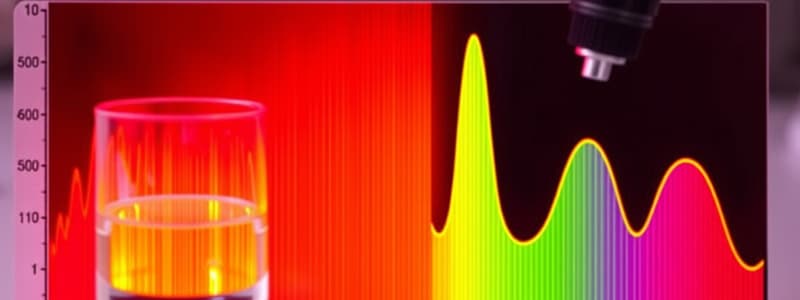Podcast
Questions and Answers
What is the function of a spectrometer?
What is the function of a spectrometer?
The instrument counts the number of photons hitting the detector in a specific period of time.
Absorption is proportional to what?
Absorption is proportional to what?
The absorbance (A) at a given λ is proportional to the concentration of the absorbing species (C).
State the Beer Lambert Law.
State the Beer Lambert Law.
Absorbance = Molar Absorptivity * Path Length * Concentration
What happens to the absorbance when the size of the cuvette is adjusted?
What happens to the absorbance when the size of the cuvette is adjusted?
How does the color of the solution relate to the color of λmax?
How does the color of the solution relate to the color of λmax?
What is the difference between parallel and serial dilutions?
What is the difference between parallel and serial dilutions?
How does the concentration of the 4th dilution using parallel dilutions compare to the concentration of the 4th dilution using serial dilutions?
How does the concentration of the 4th dilution using parallel dilutions compare to the concentration of the 4th dilution using serial dilutions?
How would an error in the first dilution of each type affect the 4th dilution?
How would an error in the first dilution of each type affect the 4th dilution?
Calculate the diluted concentration if you have a 5.25 x 10^-4 M stock solution and mix a 3.00 mL aliquot with 2.00 mL of diluent.
Calculate the diluted concentration if you have a 5.25 x 10^-4 M stock solution and mix a 3.00 mL aliquot with 2.00 mL of diluent.
What does the perceived color of objects depend on?
What does the perceived color of objects depend on?
Flashcards are hidden until you start studying
Study Notes
Spectrometer Function
- A spectrometer counts the number of photons reaching the detector within a specific timeframe.
Absorption Proportionality
- Absorbance (A) correlates with the concentration (C) of the absorbing species in many materials.
Beer Lambert Law
- Formula: Absorbance = Molar Absorptivity × Path Length × Concentration.
Cuvette Size Impact on Absorbance
- Enlarging the cuvette increases absorbance, while reducing its size decreases absorbance.
Color Relationship with λmax
- The solution's color is typically complementary to the wavelength color based on the color wheel.
Types of Dilutions
- Dilutions can be arranged in two ways: serial dilutions (stepwise) or parallel dilutions (side by side).
- Primary goal is to achieve specific concentrations from a single known "stock" solution.
Concentration Comparison of Dilutions
- The 4th dilution in parallel is at 11% stock, while in serial it is at 0.01% stock.
- Serial dilutions have a narrower concentration range (0.01% to 10%) compared to parallel dilutions (11% to 78%).
- Serial dilutions allow for lower concentrations and have larger room for error.
Error Impact on Dilutions
- An error in the serial dilution affects subsequent dilutions, making the 4th dilution incorrect.
- An error in parallel dilution does not affect subsequent dilutions as each is independent.
Calculation of Diluted Concentration
- For a 5.25 x 10⁻⁴ M stock solution diluted with water:
- Using M1V1 = M2V2, diluted concentration is 3.15 x 10⁻⁴ M.
Perceived Color of Objects
- Object color is determined by how light interacts with electrons in molecules or atoms.
- The absorbed wavelengths dictate the perceived color, which is influenced by the object's molecular structure.
- The perception of color starts with light absorption by molecules in the observer's eye, leading to the transmission or reflection of particular wavelengths.
- A blue object absorbs other wavelengths, reflecting or transmitting blue light to the observer.
Studying That Suits You
Use AI to generate personalized quizzes and flashcards to suit your learning preferences.




